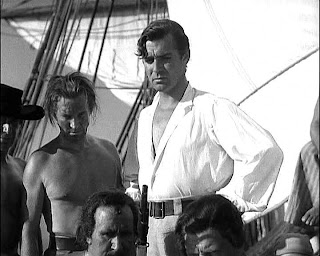"When you're back in England with the fleet again, you'll hear the hue and cry against me. From now on they'll spell mutiny with my name." -Fletcher Christian to Byam, Mutiny on the Bounty
Okay, at the risk of completely destroying my credibility as a serious blogger and alienating my male readers (if any)--Clark Gable as a shirtless buccaneer = yum. That's it, I swear, at least until
Gone With the Wind
. I should get credit for holding back in my last movie post. What was I writing about again...right! Adventure, intrigue, foreign lands, high seas, dastardly villains, tragic heroes, romance and of course...ahem...Clark Gable...
The Plot
Fletcher Christian, played by
Clark Gable, is first mate on a ship called
The Bounty, headed to Tahiti for a two year journey to bring back breadfruit trees. He rounds up sailors by both jails and
impressment, forcing in particular a young man who does not wish to leave his wife and son. Ensign Byam, played by
Franchot Tone, coming from a long line of wealthy and power naval officers, naively heads to the ship as well in his first naval posting as midshipman. He has been given his post by a Sir Joseph Banks, a wealthy family friend with great connections who has charged Byam with writing a Tahitian dictionary. Captain Bligh, played by
Charles Laughton, prepares to launch the ship by first flogging a man who has given offense. Just before the flogging begins, the man is pronounced dead. This does not deter Bligh who insists the flogging be carried out anyway.
 |
| Fletcher Christian and Captain Bligh |
This incident sets the tone for a long voyage of cruelty and suffering for the crew. Not even the officers are exempt, and Bligh takes particular delight in the fact that because they sail in wartime (though they are not actually fighting) he has the power to reprimand anyone for any offense. He skimps on food and pockets the funds, demands insane amounts of work, and comes up with terrible punishments for the least offense. Christian, clearly a man of good principle and experience, is forced to stand by and hold on to his temper as Bligh makes everyone miserable. Bligh is pronounced one of the best sailors Christian has ever worked for, but the worst captain.
 |
| Fletcher Christian refuses to sign the log |
When Bligh asks Christian to sign the ship's log documenting falsified rations, Christian refuses. Bligh calls the whole ship and is about to reprimand him, when they finally sight land. The Tahitians row out to meet them, and Bligh greets the Tahitian chief, Hitihiti, whom he has met before. They exchange gifts, and Byam, who has proven himself to be an honest, innocent young man and a friend of Christian's, is invited to live with the chief for the few months they intend to stay, in order to write his dictionary. While some of the sailors are granted brief periods of leave, Bligh takes great pleasure in denying Christian his. Only with the interference of Hitihiti does Christian finally get shore leave.
 |
| Christian and Byam on Tahiti |
Byam has enjoyed his time on an island portrayed as a primitive paradise, in direct opposition to the horrors of the ship. He works on his dictionary, flirts with an island woman, Tehani, and carouses with Hitihiti. When Christian finally joins him, he connects with life on the island and falls deeply in love with Hitihiti's beautiful granddaughter, Maimiti. When Byam and Christian finally leave, Christian swears to her he will return, much to Byam's chagrin.
 |
| Maimiti and Fletcher Christian |
Meanwhile, on the ship, Bligh has thrown several crew members in irons for sneaking off to see the island. He has also secretly decided to cut the crew's water rations in half in order to better take care of the breadfruit plants. He even causes the death of the crew's beloved old drunken medic, by forcing him to come on deck while he is sick and then flogging him. Bligh snatches away Maimiti's present to Christian (some pearls) on a slim pretext and then beats and starves those he had put into irons, including the young man Christian had forced to sail away from his family before then promising to protect him. This finally causes Christian to snap. He frees the prisoners, grabs up some guns, and subdues Bligh and his few loyal crewmen. He does not allow the crew their revenge but puts Bligh and his men in a lifeboat with basic supplies and pushes them out to sea. Byam tries to fight back, by Christian knocks him out. He and a few others cannot fit in Bligh's boat, and are therefore forced to stay with the mutineers as they head back to Tahiti. Bligh and the others nearly die, but because of Bligh's incredible seamanship, manage to make it to safety after a grueling 47 day voyage. Bligh vows vengeance.
 |
| The Bounty |
It is several years later and everyone is living in paradise on Tahiti. Both Byam and Christian have married their women, and Christian now has a son. Everything is fine until a British ship is sighted. Christian takes nearly all of the mutineers and departs on
The Bounty for safer shores. The few loyalists, including Byam, along with a mutineer, the young man with a family, board the British ship, only to discover Bligh, who has decided they are all mutineers in league with Christian. Bligh puts them in irons and pursues Christian doggedly. He is forced to give it up only when his new ship,
The Pandora, capsizes and he must row to safety. Bligh does manage the get the few man he found court-martialed, and enjoys presenting an edited view of the mutiny and voyage to the naval court back in England. The men's pleas of innocence and Byam's impassioned speech falls on deaf ears; they are all sentenced to hang. The naval judges, while respecting Bligh's skill, refuse to shake his hand. Byam is finally saved through the influence of Sir Joseph and Byam's own family, who convince the King to grant him a pardon. Though the other men hang, Byam starts off on his next journey and to what will be a great naval career.
 |
| Bligh is subdued by his crew |
Christian brings the mutineers, their families, and various Tahitians on a long voyage, and just as they start to complain and turn violent, he sights Pitcairn, their new island home. He describes the new utopia they will build, and then they take to the life boats before dashing
The Bounty on Pitcairn's treacherous rocks so that they will never be found again.
 |
| Christian contemplates his mutiny |
The History
Mutiny on the Bounty is based on the novel that is based on the real life story of the mutiny that occurred on the British Royal Navy ship
HMS Bounty on the 28th of April in 1789. The novel,
Mutiny on the Bounty
, is the first of a three-part series written by Charles Nordhoff and James Norman Hall in 1932. Because of this, the movie isn't 100% historically accurate, though it does manage to stick to the main facts. Byam is a character based on actual crew member Peter Heywood, and accounts of Bligh's cruelty and Christian's heroics are somewhat exaggerated. It is now believed that Bligh was more lenient than most navy captains of the time, while Christian was described as "strange" and "brooding." Bligh's reputation today is most likely due to a slander campaign started by the families of both Christian and Heywood after Bligh returned to the sea. The mutineers did end up on Pitcairn, and almost all of the 50 people on that island today are descended from the Tahitians and mutineers that first inhabited it. After Christian settled the island, however, the place descended into lawlessness and all except for two of the mutineers brutally murdered each other. It is unclear even today how Fletcher Christian met his end; while some believe Christian was murdered, others claim he committed suicide.
 |
| Captain Bligh and crew members |
Largely because of production setbacks and location shooting in Tahiti (including replicas of both
The Pandora and
The Bounty), this picture cost MGM nearly $2 million to make, the most they had spent on a film since 1926's
Ben-Hur
. Though Gable initially didn't like Tone, because of a bitter rivalry for the affections of Joan Crawford, they ended up as good friends by the end of the picture. But Gable and Laughton fared far worse, as Gable did not approve of Laughton's homosexual lifestyle (a fact producer Irving Thalberg was counting on to create further enmity between the characters). Mayer didn't understand how the film would make a profit, especially as it had no female leads. Irving Thalberg had no such qualms, saying "people are fascinated by cruelty, and that's why
Mutiny will have appeal." He was right; Mutiny would go on to be an instant hit with both critics and audiences while winning the Academy Award for "Best Picture." It would be the last film to win "Best Picture" without winning anything else, but it received nominations for directing, writing, score, and film editing and is the only film in history to have 3 Oscar nods for "Best Actor." Though there have since been many remakes, this film is largely considered the best of the
Bounty films. Clark Gable would later say this was the best movie he was ever in, while Charles Laughton claimed "It's got so that every time I walk into a restaurant I get not only soup but an impersonation of Captain Bligh." It is #86 on AFI's 2008 list of
100 Years...100 Movies and Captain Bligh is #19 on their list of
100 Years...100 Villains.
 |
| Christian subdues Byam during the mutiny |
Frank Capra, as the new Academy president, had to pull serious strings to get anyone to come to the Awards that year in 1935. The
Screen Director's Guild was created, and its members were encouraged not to attend the Awards. Everyone, even the studio bosses, were fed up with the Academy's inability to solve labor disputes, and the Director's Guild published a newsletter claiming that, "the sooner it is destroyed and forgotten, the better for the industry." Dorothy Parker of the
Screen Writer's Guild claimed "Looking to the Academy for representation was like trying to get laid in your mother's house. Somebody was always in the parlor watching." Without studio backing, Academy execs had to use their own money for the banquet and statuettes. Capra hired "Price, Waterhouse," to prevent last year's Bette Davis disaster and then decided to give
D.W. Griffith an honorary Oscar for being "the father of American cinema." Griffith's tribute was a brilliant move; though less famous faces appeared than the year before, Hollywood still came and honored Griffith with the first ever Academy Award standing ovation. But the tough times weren't over for the Academy and "Best Adapted Screenplay" winner
Dudley Nichols refused his Oscar and mailed it back to Capra, despite Capra's protests that the awards themselves were non-political. Capra would have to come up with even better ideas for next year...
The Verdict?
Like
Cavalcade a few years before, Frank Lloyd managed to produce another sweeping epic in
Mutiny on the Bounty. From the scenery to the costumes to the acting, it is impossible not to notice that this film is an epic built on a grand scale. I think that perhaps this is Lloyd's style, and he is pioneering the genre of epic for decades to come. It is hard to imagine that a film like, say,
Gladiator could have been made without first a
Cavalcade or a
Mutiny on the Bounty. This film set the tone for the epic genre, and for that alone should be lauded.
I find myself, strangely enough, comparing this film to
The Great Gatsby (perhaps as a former English major I can't help it). Byam is a kind of Nick Carraway character, the narrator through whose eyes we see the story. Byam, like Nick, is straddling the two worlds of Christian and Laughton, much to his own discomfort. His is a coming of age story, from innocence to manhood. Byam is not the hero, though he possesses some heroic qualities that show up mainly in the end. And if Byam is Nick, then conversely Fletcher Christian is Gatsby. Enigmatic, brave, and very definitely heroic, Christian walks the line between right and wrong, just as Gatsby often does. More than that, however, is the sense that both these characters are leading lives that are larger than they are. Gatsby and Christian are not real men, they are both too heroic, and too tragic. They are colored by our narrator's hero worship, but more importantly by the actions they take. Christian is unimportant without his mutiny, just as Gatsby is unimportant without his lifestyle and pursuit of Daisy. Like men that are larger than life, we never get inside their heads. We are human, like Byam, and as such only get to watch as the hero plays his part. Gable is quite good at the level of bravado this takes, he is almost a cliched hero in his strong moral stance.
 |
| Charles Laughton as Captain Bligh |
And then, finally, there is Captain Bligh. Compare him to Tom Buchanon if you will, surely both are hypocritical, pompous assholes who view their underlings, including our hero, as unimportant non-humans. But even on his best day, Tom Buchanon doesn't even come close to being as gut-wrenchingly evil as Laughton's Captain Bligh. Let my metaphor fail me here; I don't care. There is nothing more fun than finding a truly great villain. Don't underestimate the power of a villain; without Charles Laughton, this movie is about a cruise ship to Tahiti. With a self-professed "face like the behind of an elephant," Laughton sneers his way through the role so thoroughly that he is barely onscreen for five seconds before you categorically hate him. And yet, I couldn't tear my eyes away from him. How far will he go? What will he do? As an audience, we love to hate him, and therefore love it as he gives us plenty of opportunities to do so. Laughton manages to brilliantly make him despicable, and yet still show the cracks in his armor. He doesn't twist his mustache; he doesn't cackle in glee. He just exudes evil from every pour while still showing us peeks at how scared he is on the inside. One imagines he was a loser as a child. Not enough, of course, to make us not hate him. But certainly enough to steal every scene.
As much as I love a shirtless Clark Gable (and believe me, I do), Laughton is the heart and soul of this movie. Watch it for the swashbuckling and the history and the scenery. But more importantly, watch it for the joy of watching Captain Bligh, who can make you flinch just with a single look.






































